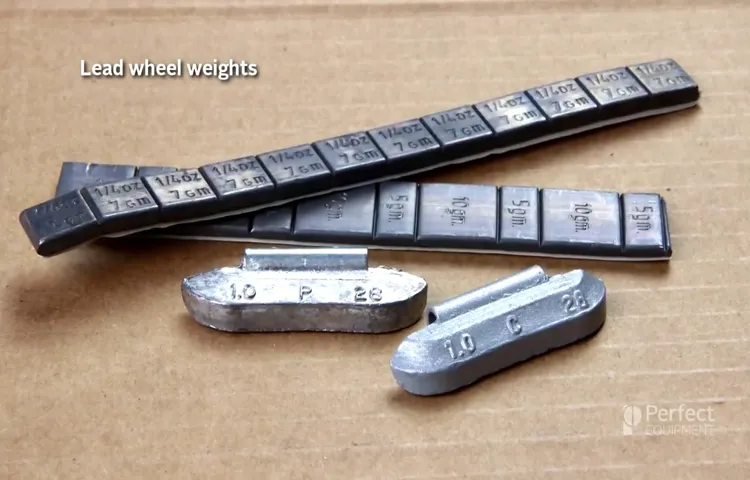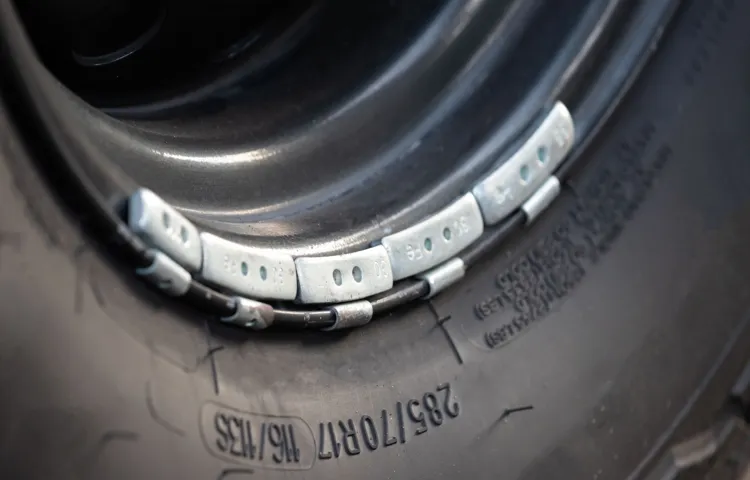Have you ever wondered what’s inside the weight that keeps your car’s tire balanced? Tire weights play a vital role in maintaining a smooth ride and ensuring maximum tire lifespan. But, what exactly are they made of? Are they heavy metals or something else entirely? The answer is a bit more complex than you might expect. Tire weights come in various forms, with each type made of a different material.
Some weight types are made of steel, while others are made of lead, zinc, or even ceramic. In recent years, eco-friendly options like tungsten or composite materials have gained popularity due to their sustainability. Each weight type has its unique advantages and disadvantages.
For instance, lead weights are durable and cheap, but they’re highly toxic and pose a health risk. Meanwhile, steel weights are more expensive, but they’re less damaging to the environment and safer to handle. In this blog post, we’ll delve deeper into the different types of tire weights and their properties.
We’ll explore the pros and cons of each weight type and highlight the factors that should influence your choice of weight. By the end of this post, you’ll have a better understanding of what goes into keeping your car’s tires balanced and rolling smoothly.
Table of Contents
Introduction
When it comes to the automotive world, there are many components that work together to ensure that vehicles can run smoothly and safely. One such component is tire weights, which help to balance the weight distribution of the vehicle and improve handling. So, what are tire weights made of? Typically, tire weights are made of either lead or steel, although there are some newer, eco-friendly alternatives emerging.
Lead weights have been used for decades due to their high density and effectiveness, but they are now being phased out due to their negative impact on the environment. Steel weights are a popular alternative, as they are more environmentally friendly and still provide a good level of weight distribution. Other newer materials used for tire weights include zinc, tungsten, and even bio-based materials, which are becoming increasingly popular in order to promote sustainability in the automotive industry.
What are Tire Weights and Why are They Necessary?
Tire weights may not be something that comes to mind when you think of car maintenance, but they play a crucial role in ensuring your vehicle performs optimally. Simply put, tire weights are small, metal or lead pieces that are attached to the rim of your tires using adhesive tape or clips. So, why are they necessary? Tire weights help balance the weight distribution of your wheel and tire assembly so that it spins evenly.
An unbalanced tire can cause vibrations, which can impact the handling of your vehicle and shorten the lifespan of your tires. Therefore, it’s important to ensure your tires are properly balanced and have the correct amount of weight attached.

Types of Tire Weights
Tire weights are essential for ensuring balance and stability on your vehicle’s wheels. There are two common types of tire weights – clip-on and adhesive – and they can be made from a variety of materials. Clip-on weights typically consist of lead, steel, or zinc and are attached to the rim of your wheel with a clip.
Adhesive weights, on the other hand, are made from steel and coated with a layer of adhesive. They are then applied directly to the inside of your rim. In recent years, there has been a shift away from using lead-based weights due to environmental concerns, leading many manufacturers to use eco-friendly alternatives such as zinc and steel.
Regardless of the type of weight or material used, it’s essential to ensure that your tire weights are properly installed and balanced to avoid any issues with uneven tire wear or vibration while driving.
1. Lead Weights
Lead weights have long been used as a means of balancing tires and improving vehicle performance. There are different types of lead weights available in the market, including clip-on, stick-on, and adhesive tape weights. Clip-on weights are the traditional type that is clipped on to the rim of the tire.
Stick-on weights, on the other hand, are stuck onto the rim and are more visually appealing than clip-on weights. Adhesive tape weights are the newest addition to the market and are ideal for those who do not want to use traditional weights on their rims. These weights are easy to install and remove, leaving no residue on the rims.
Lead weights are an effective solution for tire balancing and can improve the overall handling and performance of a vehicle. However, it is important to note that lead is a toxic material, and proper disposal of used weights is essential to prevent environmental damage.
2. Zinc Weights
Zinc Weights When it comes to tire weights, there are various options to choose from, and one popular choice is zinc weights. These weights are made from a zinc alloy, which is known for its durability and resistance to corrosion. There are two types of zinc weights: clip-on and self-adhesive.
Clip-on weights are the traditional option that requires a special tool to attach to the rim and are more secure than adhesive weights, which stick to the rim and can shift over time. Zinc weights are commonly used because they are non-toxic, making them a more environmentally friendly option compared to lead weights. They also come in different sizes and shapes, allowing for more precision in wheel balancing.
Overall, zinc weights are a reliable and efficient choice for balancing tires and ensuring a smooth ride on the road.
3. Steel Weights
When it comes to tire weights, steel weights are a popular option. They are durable and can withstand extreme temperatures, making them perfect for use in harsh weather conditions. Steel weights come in two main types: clip-on and adhesive.
Clip-on weights are attached to the rim with a clip, while adhesive weights are glued onto the inside of the rim. Clip-on weights are the more traditional option and are easily adjustable, while adhesive weights are more discreet and create a sleeker look. Steel weights can also come in different shapes and sizes to fit different tire sizes and types.
It’s important to choose the right weight for your tires to ensure it provides the necessary balance and stability while driving. So whether you’re going off-road or just cruising down the highway, steel weights are a reliable option for keeping your tires in check.
4. Brass Weights
When it comes to tire weights, there are several types available in the market. One popular type is brass weights. These weights are made of brass and are available in various sizes and shapes, making them suitable for different types of tires.
Brass weights are particularly useful for heavier vehicles, as they are durable and can withstand the wear and tear of long journeys. They also offer excellent balance, which is essential for maintaining an even weight distribution on the tires. One of the advantages of brass weights is that they are resistant to corrosion, which helps them to maintain their effectiveness for extended periods.
Additionally, they can be easily installed onto the wheels at the tire shop, and they come with different attachments to ensure they securely attach to the rims. Overall, brass weights are a reliable and durable option for maintaining the balance of your tires, providing you with a safe and comfortable driving experience.
How are Tire Weights Installed?
Tire weights are important for maintaining the balance and stability of your vehicle’s tires. These weights are usually made of lead, steel, or zinc, and they are installed by attaching them to the rim of the wheel. The weight of the balancing weight is determined by the size and weight of the tire.
The process of installing tire weights involves first determining where the imbalance is by spinning the wheel and determining the amount and location of the weight needed. Once this is determined, the correct weight is selected and placed onto the rim of the wheel. It’s important to note that tire weights require a specific amount of pressure to be applied during installation to ensure they remain in place.
Some modern cars and trucks nowadays come with dynamic wheel balancing, which involves installing a sensor to detect imbalances in real-time, therefore eliminating the need for additional weights. Ultimately, tire weights play a crucial role in ensuring a safe and smooth ride when driving, so it’s important to keep them maintained and installed properly.
1. Clip-On Weights
When it comes to Tire weights, there are various types of weight installations one can choose from. The most popular of these installation methods are Clip-On Weights. It’s easy to install and works quite effectively.
You attach these Clip-on weights to the outer edges of your rims. Their main purpose is to balance the tire and prevent any vibration during driving. Installing these weights is pretty straight-forward, and you need not be a technician to get the job done.
But, it’s advisable to take your car to a professional technician in the event of needing any additional work or repairs. Clip-on weights are the most affordable and effective method to balance your tires. You can be sure that with the proper installation of these weights, your vehicle will deliver a smooth and comfortable ride for years to come.
2. Adhesive Weights
Adhesive weights are an effective and easy way to balance your tires, and they are installed directly onto the rim of the tire. The first step is to clean the surface of the rim so that the adhesive can properly stick. Next, the technician will carefully measure and cut the appropriate amount of weight needed to balance the tire.
The adhesive backing is then peeled off, and the weight is carefully pressed onto the rim. The technician will then use a specialized tool to ensure the weight is securely in place, ensuring it won’t come off while driving on the road. Adhesive weights are typically less visible than traditional clip-on weights and won’t harm your rims’ finish.
Plus, it won’t rust and corrode like clip-on weights, making it a safer and more durable option. Overall, adhesive weights are an excellent choice for those who want a balanced tire without sacrificing the appearance of their wheels.
3. Bolt-On Weights
If you’ve ever been to a tire shop, you may have noticed how the mechanics attach weight to your tires. These weights are called bolt-on weights and are the most common type used for balancing tires. As the name suggests, they are bolted onto the wheel rim in precise locations to counterbalance any uneven weight distribution.
The weights themselves are usually made of steel and come in different shapes and sizes, depending on the type of wheel they are being attached to. The installation process involves first removing any old weights, cleaning the area, and then attaching the new bolts with the correct torque specification. Once everything is securely in place, the wheels are spun on a balancing machine to ensure that they are perfectly balanced.
This is crucial to prevent any vibrations, uneven tire wear, and potential safety hazards while driving, especially at high speeds. So, next time you visit a tire shop, you’ll know exactly how those bolt-on weights are installed and their important role in keeping your vehicle running safely on the road.
Conclusion
In conclusion, tire weights are made of a compound that is specifically designed to keep our vehicles balanced and on the road. It’s not just a simple piece of metal, but rather a highly-engineered material that can withstand the harsh conditions of the road while maintaining its effectiveness. So while it may seem like a small detail, the humble tire weight plays an important role in keeping our wheels rolling smoothly.
Now if only they could make a tire weight that would balance our lives as effortlessly as it does our cars…”
FAQs
What are the most common materials used in making tire weights?
The most common materials used in making tire weights are steel, zinc, and lead.
Are tire weights safe for the environment?
Tire weights made of lead have been found to pose a threat to the environment, but there are now eco-friendly alternatives like steel or zinc.
Do all vehicles require tire weights?
No, not all vehicles require tire weights. They are usually used to balance tires on cars, trucks, and other large vehicles.
How are tire weights attached to the wheel?
Tire weights can be attached to the wheel using adhesive tape, clips, or a combination of both methods.
Can tire weights affect the performance of a vehicle?
Yes, improperly balanced tires due to missing or misplaced tire weights can lead to poor vehicle handling, faster tire wear, and reduced fuel efficiency.
How often should tire weights be checked?
Tire weights should be checked whenever the tires are balanced, and then periodically thereafter during routine maintenance.
Can tire weights cause tire damage or punctures?
It’s rare, but damaged or poorly installed tire weights can cause tire damage or punctures. It’s essential to have them installed and maintained correctly.



